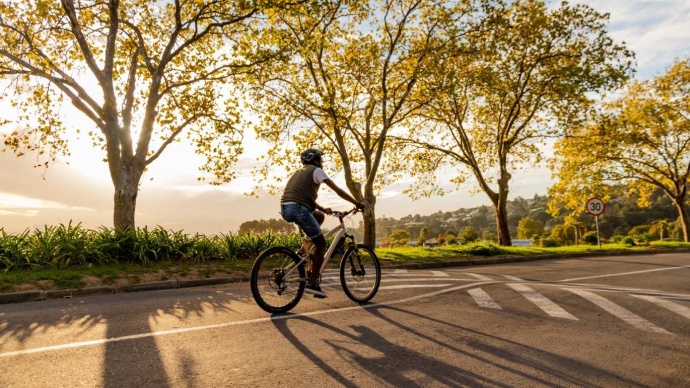
Portugal is more than sun, sea and splashes of coastal tourism. It’s an invitation to linger, to connect, to truly slow travel. From sun-dappled vineyards in Douro and Vinho Verde to quaint villages off the beaten path, this country rewards those who pause, breathe and choose depth over speed.
In this guide, we explore why slow travel in Portugal matters, uncover authentic experiences tailored to those seeking mindful immersion, and showcase how Authentic Trails’ self-guided itineraries bring this philosophy to life.
What is slow travel and why Portugal is its ideal canvas
Slow travel emphasizes quality over quantity: fewer destinations, richer encounters, deeper immersion. Rather than ticking boxes, you listen, taste, linger and transform.
Portugal is perfect for this approach:
- Small scale, big heart: compact geography means short travel legs between regions;
- Rhythmic culture: villages follow their own schedules, like late dinners and lunchtime parties;
- Rich traditions: from grape harvests and olive oil pressing to crafts and age‑old cuisine;
- Community connections: warm, generous locals eager to share stories, as long as you stay awhile.
Slow travel Portugal isn’t about seeing all of Portugal. It’s about letting Portugal see you: at your own pace, your own way.
Key principles of slow travel in Portugal
- Stay longer, travel less: base yourself in villages or wine regions, skip the one-night hotel hops. This leaves time to uncover hidden gems: family-run tascas, stone chapels, ancient terraces;
- Follow the local pace: allow for midday rests, erratic ferry schedules, harvest festivals, embrace rather than fight this flow;
- Walk or bike your way in: whether meandering Douro Valley by foot or cycling Vinho Verde lanes, slow travel is most immersive on foot or saddle;
- Connect with people and place: sell‑sliced bread at the market. Chat with vine-tenders or olive-mill workers. Get invited to a neighbor’s kitchen for a slice of cake;
- Eat seasonally and locally: let the market guide you. Wild asparagus in spring, chestnuts in autumn. Food tells deeply rooted stories;
- Embrace mindfulness: observe morning light, revel in vineyard panoramic silence, savor every sip and season.
Ideal destinations for slow travel in Portugal
Instead of rushing from landmark to landmark, slow travel lets us linger, listen and experience the country, one thoughtful step at a time. The destinations below are perfect for those seeking authenticity, calm and meaningful encounters.
1. The Douro Wine region
The UNESCO-listed Valley of the Douro unfolds in steep terraces, historic quintas (vine estates) and lazy riverside paths. Here, everything slows down: boats drift, wine ages slowly in barrels and epic views call for unhurried appreciation:
- Wander historic vineyards;
- Pause at miradouros (viewpoints);
- Savor old port and seasonal tapas;
- Hike along seldom-traveled trails.
2. Vinho Verde countryside
Northwest Portugal’s leafy hills, dotted with granitic villages and manor houses, whisper of tales centuries old. The region extends beyond wine to cobbled alleys, mossy bridges and pastoral calm.
- Cycle stone-arched bridges;
- Meet quinta families making vinho verde;
- Delight in farm-to-table meals under oak canopies.
3. Off-beaten-track villages
From Monção to Pinhão, these villages embody Portuguese identity. Romanesque churches, board games in village squares, elders chatting under shade, each setting is an invitation to inhabit slow travel’s ethos.
Authentic Trails’ slow-travel journeys in Portugal
Authentic Trails offers carefully crafted itineraries that embody slow travel. With self-guided structure, you walk or ride from village to vineyard, lodge to lookout, café to cantina, each transition a discovery.
🚴 Douro Wine & Food Lovers Self-Guided Hike Tour
- Route: footpaths meandering through terraced vineyards, stone houses and river views;
- Highlights: wine tastings in hillside quintas, guided cellar visits, regional lunches, village cafés;
- Time: four to six hour daily segments leave room for naps, unplanned detours and slow meals.
🚴 Vinho Verde Wine & Food Lovers Self-Guided Bike Tour
- Route: rolling lanes, country roads and small hamlets;
- Highlights: visits to family-owned wineries, chef-led dinners, artisan view stops;
- Time: gentle cycling with optional detours - ride, rest, taste.
🚴 Douro Valley Wine & Food Lovers Self-Guided Bike Tour
- Route: scenic loops hugging the Douro River, through vineyards and olive groves;
- Highlights: riverside picnics, lunch at quintas, sunset tastings;
- Time: 25–50 km per day at your own speed, with plenty of views calling for breaks.
Who benefits from slow travel in Portugal?
- Curious food and wine travelers looking to go beyond a tasting room, meet vintners and forage local ingredients;
- Active culture seekers who enjoy daily walking or biking but don’t want to be on a rigid tour schedule;
- Digital nomads and freelancers seeking scenic stays with work flexibility and mindful exploration;
- Couples and friends craving deep discovery over crowded tourist itineraries;
- Mindful escapers who want to disconnect, breathe and sync to Portugal’s rhythm.
Slow travel pratical tips
- Pack light: luggage transfers between lodges help you walk or ride unencumbered;
- Wear layers: morning mist in valleys can turn to warm sun by midday;
- Learn key portuguese words: “Obrigado,” “Bom dia,” names of local dishes, and a few wine terms go far;
- Stay farmhouse or quinta: rural stays mean waking to birdsong and sipping terrace coffee;
- Choose shoulder season: April to June and September to October offer quiet trails and ideal weather;
- Book wine tasting in advance: many family-run quintas need notice for intimate visits.
Sustainability and authentic slow tourism
- Supporting local economies: your walking and eating pay wages in small towns, empower family-run quintas and preserve traditions;
- Minimizing footprint: you rely on feet and bikes, not mass transit or charter fleets;
- Cultural conservation: you keep churches, crafts, gastronomy and rural villages alive by choosing immersion over social media snaps;
- Eco-aware habits: stick to existing paths, carry reusable bottles, respect nature and farms. Slow travel in Portugal can, and should, be light on impact.
How to plan your slow travel journey
- Choose your region: decide between the vineyard-rich Douro, the lush Vinho Verde hills, or a custom mix;
- Select a self-guided itinerary: enjoy expert planning and local support with Authentic Trails;
- Decide trip length: packages usually span 4–7 days; extend by adding on extra vineyard visits, city stays, or extension days;
- Book smartly: reserve villa/quinta lodgings early, especially during harvest and wine festival months;
- Travel mindfully: enjoy seamless baggage transfers, tailored guidance, digital route apps. You supply the pace and spirit.
In a world obsessed with instant everything, slow travel in Portugal offers a mindful alternative: time to savor, sense and connect. Your reward? A richer understanding of vineyards, people, heritage and the rhythms that define this luminous country.
Authentic Trails crafts these slow travel experiences with heart and expertise: self-guided, unhurried, deeply rooted journeys that welcome curiosity, rest and wonder.
More to explore:

